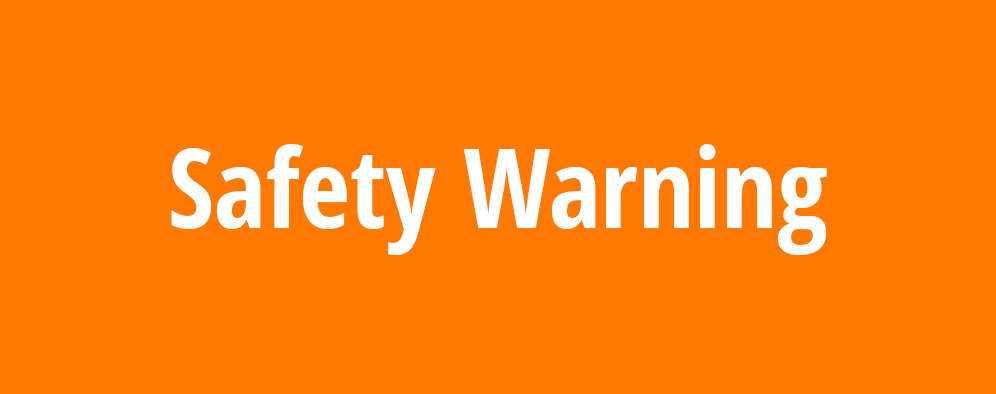
Safety warnings are required to be sent when certain crimes present a serious or continuing threat to the campus community.
The Jeanne Clery Disclosure of Campus Security Policy and Campus Crime Statistics Act, commonly referred to as the Clery Act, was signed into federal law in 1990, to "keep students, parents, and employees well informed about campus security." To comply with the act, institutions of higher education must release an annual safety report, provide a daily crime log, and send timely warnings to the campus community in certain circumstances. These are called Safety Warnings at the University of Utah.

Many questions can arise when these alerts are sent to our community. This FAQ provides more information about Safety Warnings.
Q: What is a Safety Warning?
A: Safety Warnings fulfill the Clery Act requirement to send timely warnings when there is a serious or ongoing threat to the campus community. These are required to be sent about certain types of crimes, occurring within certain geography specified by the Act, that poses a serious or ongoing threat to the campus community. The Clery geography covers campus, public property within or immediately adjacent to the campus, and noncampus buildings or property the university owns or controls and is used by students for educational purposes.
Q: What kinds of incidents require Safety Warnings?
A: Any Clery crime occurring within Clery geography that poses a serious or ongoing threat to the campus community requires a Safety Warning. Clery crimes include murder, non-negligent manslaughter, and manslaughter by negligence, aggravated assault, arson, burglary, robbery, motor vehicle theft, rape, fondling, incest, statutory rape, liquor law violations, weapons possession, drug abuse violations, hate crimes, domestic violence, dating violence and stalking.
Q: Why are these Safety Warnings important?
A: Because Safety Warnings are sent when there is an ongoing threat to the community, they are designed to provide individuals with information so they can make the best safety decisions for themselves. The protective actions listed at the end of the alert have been thoughtfully developed with insight from experts across campus to provide useful tips to those who receive them. These alerts promote transparency and accountability while creating a safer environment for all.
Q: Are these warnings a requirement for all universities?
A: Yes. The Clery Act requires institutions to issue an alert when a Clery crime occurring within Clery geography poses a serious or ongoing threat to the campus community. The Department of Education emphasizes the importance of making determinations for issuing these warnings on a case-by-case basis using policies pre-established by the institution that align with Clery requirements.
Q: Who decides when to send a Safety Warning?
A: The University of Utah has a Clery compliance officer who works closely with University Police and the Office of General Counsel to determine whether a particular incident requires a safety warning. The U also has a Clery Compliance committee, which is comprised of individuals whose job responsibilities intersect with safety. This group meets regularly to review reportable offenses, identify and develop training for individuals with reporting responsibilities, create and disseminate the Annual Security & Fire Report, among other things.
Q: How long does it take for a Safety Warning to be distributed after an event is reported?
A: Although the Clery Act does not define a specific timing requirement, the intent of a warning regarding a criminal incident is to enable people to protect themselves. This means that a warning should be issued as soon as pertinent information is available.
At the University of Utah, our goal is to have a Safety Warning sent within hours of an incident being reported. The time can vary for a variety of reasons. For example, sometimes crimes aren’t reported to police until hours, days or even weeks after they occurred. Depending on the timeframe, it may be determined that there is no longer a threat to the campus community and no warning will be disseminated. If a crime is reported to U Police quickly, it takes some time to intake the report and identify the threat level. Nonetheless, the U remains committed to sending alerts as quickly as possible so individuals can make the best safety decisions for themselves.
Q: Who receives Safety Warnings, and how?
A: The University of Utah uses a multimodal dissemination method. In certain situations, alerts may be sent to those most likely to be affected. Safety Warnings may be sent via text message if the cell phone number is on file and via email to University of Utah email addresses. They are also posted to the Campus Alert website, and the U’s official social media platforms (Facebook and Twitter).
Q: Why do I receive several Safety Warnings about the same case?
The amount of information presented in the original Safety Warning will vary depending on the circumstances and status of the investigation. In most cases, subsequent alerts are provided to inform the community about important updates in the case, new details, and the outcome of a case. Sometimes updates are shared to let the community know the investigation is continuing.
Q: Are there different kinds of alerts?
Yes, there are two alert types required by the Clery Act: timely warnings and emergency notifications. The U uses three levels of alerts that are color-coded according to the level of importance. Red Emergency Alerts are reserved for critical emergencies requiring immediate action—including natural disasters and other situations posing a direct and immediate threat to personal safety. Orange Safety Warning Alerts issued as a result of a Clery Act crime that has occurred on campus property, non-campus property or public. Yellow General Safety Information notices are sent to notify the campus community about non-urgent safety matters, such as emergency roadwork, business continuity interruptions or inclement weather.

Q: What is the U doing to mitigate the negative impacts Safety Warnings can have on students and the U community?
The University of Utah recognizes that Safety Warning messages can have profound impacts on those who receive them and can be triggering for those who have experienced violence. Therefore, they are thoughtfully prepared to both comply with federal regulations and also mitigate negative impacts by avoiding detail about the victim(s). Language used in the alerts, as well as the prevention and safety tips, were developed with insight and feedback from the campus community, including staff and faculty who have expertise in different aspects related to interpersonal violence, discrimination, mental health, etc. These will be reviewed regularly to ensure the U is using the most up-to-date language and best practices related to Safety Warnings.
*More information available here.

3 thoughts on “What you need to know about safety warnings”
Comments are closed.